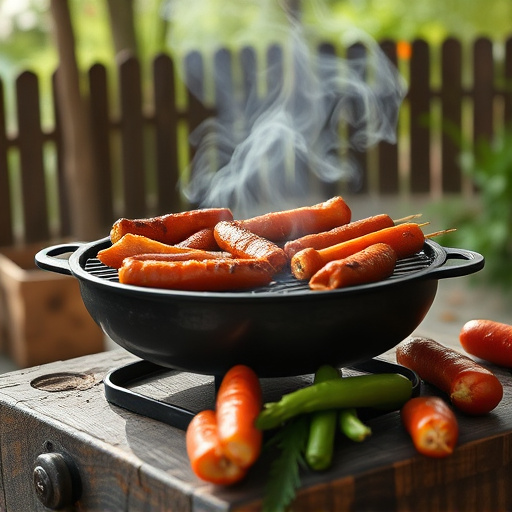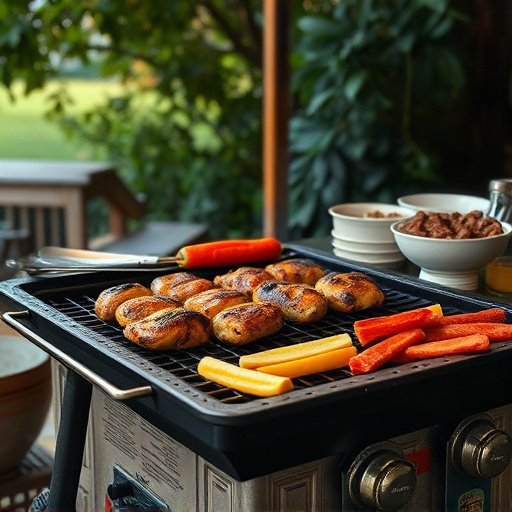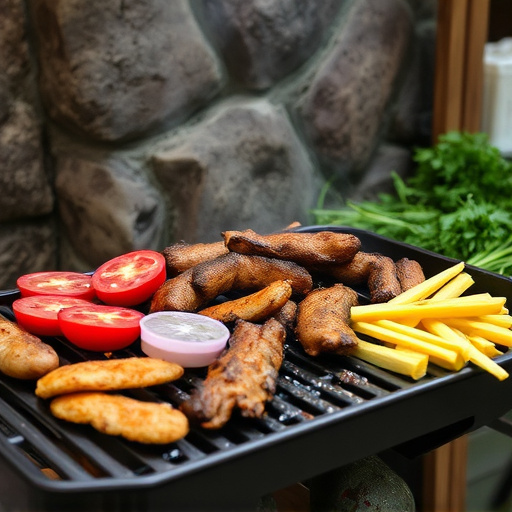To craft the perfect BBQ Beef Rib Recipe, start by selecting meaty, marbled cuts like baby back or St. Louis style ribs, sourced locally and grass-fed for optimal quality. Prepare them by removing the membrane and dry rubbing with spices, resting for an hour. Trim excess fat and "memerize" to ensure even cooking. Marinate with a blend of oil/vinegar and spices for 2+ hours, or overnight, for maximum flavor absorption and a tender, juicy result with a delicious caramelized crust.
Looking for the ultimate smoky, flavorful BBQ beef rib recipe? Grilling perfect ribs is an art, and we’re here to guide you through every step. From choosing the right cut of ribs and preparing them for grilling, to mastering marination techniques and ideal grilling strategies, this comprehensive guide will transform you into a rib-master. Discover tips on serving suggestions and variations to impress your taste buds.
- Choosing and Preparing the Ribs
- – Selecting the right cut of beef ribs
- – Tips for trimming and preparing the ribs
- Marinating for Maximum Flavor
Choosing and Preparing the Ribs

Choosing the right beef ribs is key for an exceptional BBQ beef rib recipe. Look for meaty, marbled cuts like baby back or St. Louis style ribs. Quality matters; opt for grass-fed, locally sourced ribs if possible. The preparation process begins by removing any membrane (also known as the “silver skin”) on the bone side of the ribs, as it can become tough during cooking. Then, dry rub your ribs with a blend of spices—a classic combination includes paprika, brown sugar, garlic powder, salt, and pepper. Letting the ribs sit for an hour or so allows the flavors to penetrate the meat, enhancing taste and tenderness.
– Selecting the right cut of beef ribs

When it comes to BBQ Beef Ribs, choosing the right cut is half the battle won. Look for ribs that are meaty and have a good marbling of fat—this ensures they’ll stay juicy and tender on the grill. The most popular cuts for this delicious BBQ beef rib recipe include baby back or spareribs. Baby back ribs have less bone and more meat, making them a bit easier to handle, while spareribs offer a richer flavor due to their higher fat content.
Remember, quality ribs should have a deep red color and minimal silver skin. This natural coating not only adds flavor but also acts as a barrier against overcooking. Properly selected ribs will result in a mouthwatering BBQ beef rib recipe that’s sure to be the highlight of your grilling sessions.
– Tips for trimming and preparing the ribs

When preparing BBQ beef ribs for grilling, the first step is to trim excess fat and membrane from the bone side of the rack. This ensures even cooking and prevents the ribs from becoming overly greasy. Use a sharp knife or a specialized rib trimmer to remove any visible fat caps and the thin membrane that sticks to the bones—a process known as “memerizing.” This step is crucial for achieving those delectable, smoky, and tender results you crave in your BBQ beef rib recipe.
After trimming, rinse the ribs under cold water and pat them dry with paper towels. This removes any excess moisture and helps the spice rub adhere better. Now, you’re ready to apply your favorite BBQ spice blend—a key element in developing that rich, savory flavor. Rub the spices generously all over the ribs, coating both sides equally for a mouthwatering BBQ beef rib experience.
Marinating for Maximum Flavor

To unlock the full potential of your BBQ beef rib recipe, marinating is a game-changer. It’s not just about adding moisture; it’s about infusing your ribs with rich, smoky flavors that’ll have folks licking their bones clean. The key lies in a well-balanced blend of spices and acids. Start with a base of olive oil or apple cider vinegar to help the seasoning adhere. Then, mix in a combination of paprika, garlic powder, brown sugar, salt, pepper, and a touch of cayenne for that extra kick. Let your ribs soak in this magical mixture for at least 2 hours—or even overnight—for maximum absorption and flavor penetration.
The marinating process isn’t just about the ingredients; it’s also about creating a barrier to lock in the juices during grilling. This step ensures that your beef ribs turn out tender, juicy, and bursting with savory flavors. When it comes time to grill, you’ll be amazed at how much easier it is to control the cooking process and achieve that perfect caramelized crust without overcooking the meat.
